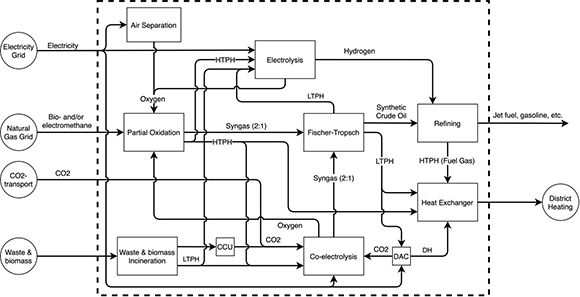Asger Vestergaard Laursen and Jeppe Bay Pedersen
Master Thesis - Energy Technology - 2020
This study investigates the prospects of adapting the gas-to-liquid (GtL) and power-to-liquid (PtL) pathways, for production of synthetic liquid fuels for the transportation sector, in the Danish energy system in 2050. The purpose is to give an overall recommendation of the most socioeconomically feasible production configuration, using GtL and PtL while utilizing the synergies that exist within sector coupling, in order to produce the Danish jet fuel demand of 50 PJ in 2050. Furthermore, the study answers questions related to the strain that is imposed on the Danish electricity network as a result of liquid fuel production through PtL, and the demand for negative CO2 emissions towards a climate neutral energy system in 2050.
This study has included the development of an energy system model in Energinet's modeling tools Sifre and ADAPT. The model in Sifre has been used to simulate the production of jet fuel, in the Danish energy system in 2050, through different liquid fuel production plant configurations, including pure GtL, pure PtL and hybrid configurations between the two pathways.
From this study it can be concluded that, deploying hybrid configurations combining the GtL and PtL pathways, the entire Danish jet fuel demand can be produced at approximately double the price of jet fuel today, while not imposing significant strain on the existing infrastructure. Of these hybrid configurations, combining co-electrolysis with either steam-methane reforming (SMR) or partial oxidation (POX) results in the lowest jet fuel prices, when considering an average of upstream methane production from biogas upgrading and methanation of CO2 in biogas, at 31.2 EUR/GJ. The results showed that, the jet fuel price in the pure GtL pathway with methane from biogas upgrading, that included POX, was lowest with a price of 25.2 EUR/GJ. However, in every variation the pure GtL pathway violates the biogas constraint meaning that the entire Danish demand of jet fuel can not exclusively be produced by GtL. The figure below illustrates the hybrid configuration including POX and co-electrolysis units for syngas production.
In general, the hybrid configurations have several advantages over the pure GtL and PtL configurations. When using only PtL it was found that a significant amount of strain could potentially be imposed on the electricity network. This could be mitigated by using the hybrid configuration. Furthermore, with the increasing deployment of renewable electricity production the electricity prices are expected to become increasingly more volatile. The consequence of this was investigated and the results showed that the hybrid configuration could potentially produce jet fuel at prices equivalent to those of fossil jet fuel in 2019.
Click at the diagram to see a larger version
Collaboration Partners
The research department System Perspective at Energinet
Energinet

